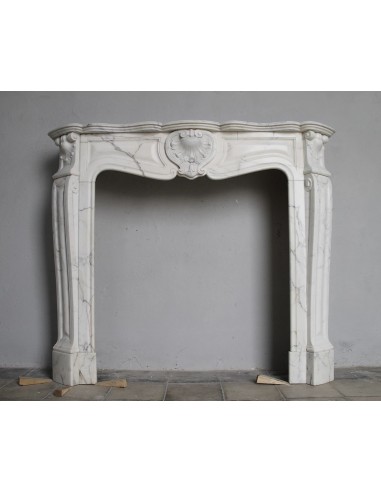SPLENDID EXAMPLE OF A LUIGI XV TROIS COQUILLES AMÉLIORÉ FIREPLACE IN ONE OF THE MOST CLASSIC, NOBLE AND ELEGANT MARBLES, A VERY FINE ARABESQUE CARRARA FROM THE FAMOUS CALACATTA QUARRY, PROVENANCE PARIS, SCULPTURE-ERA NAPOLEON III.
But how, you will say, it looks like a fireplace quite similar to so many others, where is all this rarity?!
It turns out that, by dint of explanation, someone will learn my work and so I will have one more competitor....
However, since I am a fool, I will also reveal this “secret” to you:
Take a good look at the photo of the front of this fireplace, in which appears with utmost evidence, a “leaf stylization” of the classic seashell (by the way, did you know that stonemasons of the time took as a model a head of vulgar as well as tender vegetables??).
The same goes for the “leafy workmanship” of the small shells at the top of the legs, also, thus finely and imaginatively interpreted by the chisel of that nineteenth-century master sculptor and Pietrasanta.
Hence the adjective “amelioré,” because this stylization involved a higher quality and quantity of sculptural work.
Another rather important note lies in its particular measurement in height, about 20 cm higher than the average fireplace of similar pattern. This rare feature was designed by the shrewdest architects when the floors of the hall in which this precious artifact would be placed were rather HIGH.
And now tell me how many times you have seen something like this.
Since you won't answer me, I will tell you, I, NEVER...of such mantels I, who have dealt with thousands in my life, will have recovered 8 or 10 specimens, which means one for every lustre..
The “piece” in question is in excellent overall condition and carries a patina that is truly impossible not to enjoy.
Obviously, only from Paris could this model have come to us (in Paris there was not only the stylistic creation represented by the Ateliers des Arts, there was also a taste and refinement that had no equal in any other population of the nineteenth century) despite being of Italian sculptural production (Pietrasanta or neighboring Lunigiana fireplaces).


































































